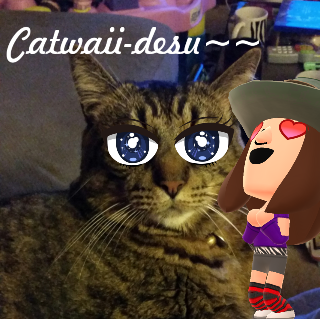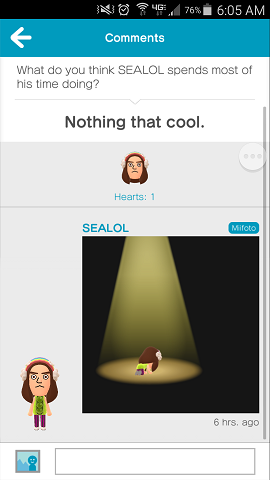My brother-in-law visited me last week. Upon opening the door, he told me I looked like Gary Busey, scoffed at the rainbow earmuffs I’d just bought, and showed off a new photo of himself wearing a shirt with hot dogs on it. When I asked what he thought I spent most of my time doing, he replied, “nothing that cool.”
 Humorous interactions like these can be common in Miitomo, Nintendo’s first-ever mobile app. Miitomo brings out their special brand of irreverent quirkiness in a big way — but only if you and your friends are up to the task. The social aspect of sharing stupid stuff with friends is the same reason why viral videos become so popular, and at first, Miitomo seems to share that spirit as an ideal platform where you can get your weird on. I’ve spent a couple weeks with this game/app, exploring its functions and trying to determine what kind of humor it’s best at while figuring out how it differentiates itself from other social communities.
Humorous interactions like these can be common in Miitomo, Nintendo’s first-ever mobile app. Miitomo brings out their special brand of irreverent quirkiness in a big way — but only if you and your friends are up to the task. The social aspect of sharing stupid stuff with friends is the same reason why viral videos become so popular, and at first, Miitomo seems to share that spirit as an ideal platform where you can get your weird on. I’ve spent a couple weeks with this game/app, exploring its functions and trying to determine what kind of humor it’s best at while figuring out how it differentiates itself from other social communities.
Miitomo doesn’t reinvent the wheel of social media, but rather offers an interesting path upon which to travel. That path uses game-like incentives and requires some friendly engagement (or insulting) with the people you know, but it still isn’t quite enough to pull you away from Facebook or Twitter. Nintendo puts forth an earnest effort to bring people together, but the cost of finding the fun in it is simply too high.
Keep Your Friends Close
Part Facebook, part Tomodachi Life, Miitomo is essentially a gamified social network. Rather than coming up with updates and statuses yourself, Miitomo asks questions such as “what did you do last weekend?” and “what month were you born?” to get conversations going. Many questions are fact-based, but some are more open-ended like “what do you look for in a life partner?” (My answer: “A pulse.”) Your answers will show up in speech bubbles, which are read aloud by friends you connect with. Friends can then click on these bubbles to hear your answers. They can also heart it (like they can in Twitter, or a Facebook like) and even provide color commentary. We’ve seen these social interactions before in the aforementioned social media platforms, so even if the setup is different in Miitomo the payoff is still the same.

Before any of this, you first have to create a Mii. If you’ve somehow avoided all things Nintendo for the past nine years, a Mii is basically a Nintendo-branded online avatar. Just like Nintendo’s other social endeavors, such as the Mii Plaza for the 3DS, you can choose different facial features to make your Mii look however you like, even if the final result looks nothing like you at all. It’s obvious Miitomo intends for your likeness to be accurately represented, as indicated by a face-generation function using your device’s camera. I generated around 20 versions of myself to choose from, some of which were truly grotesque, before choosing one I was happy with. This gamification of your image isn’t too different from what you’d see in a proper character creation phase of other games, but unlike other games Miitomo is not an isolated experience; you have to play it with friends to “play” it at all. Even so, the fun begins when you realize this and decide to bend the rules a little. I scanned in some other faces, including a bottle of ketchup, as well as my cat. Miitomo follows the trend that Facebook and Twitter set in that you don’t have to choose a real picture of yourself to be “you,” rather it’s the context that’s important. And for better or worse, that context is everything in Miitomo.
Any social network worth its salt is nothing without having people to interact with, and Miitomo is no different. You can add friends by linking your Miitomo account to your Facebook and Twitter profiles, so even if you do end up using a ketchup bottle for a face, your acquaintances will still see that it’s you. As long as you’re linked up, you can share Miitomo answers on those other social media platforms. To me, this makes for some interesting cross-pollination I wouldn’t have expected, as I’d naturally assumed Miitomo was trying to pull users away from Facebook and Twitter. And the thing that would differentiate them would be the gameplay, the context for all of this.
The main “gameplay” loop revolves around listening to and commenting on your friends’ questions, which earns you coins you can spend to buy outfits for your Mii. Clothes change everyday, Animal Crossing style, offering daily incentive to check in and see what’s trending. You get several thousand coins just for starting up, which you can redeem for clothing or game tickets, the latter of which you can spend on a pachinko-style mini-game to win rare outfits. And just like Animal Crossing, many outfits really are rather stylish, and can look quite smart with a little effort and coordination.

My first reaction was to start snatching up stuff I’d wear in real life; after all, I had settled on a Mii that looked more like me and much less like a bottle of ketchup. But I was already thinking of Miitomo as a game, and as a game I wanted to treat it as such by trying to mess around. I chose the gaudiest clothes I could buy, including a zebra print shirt without shoulders and a steampunk hat. This is Miitomo’s answer to changing up your Facebook profile picture, and it is a bit of good incentive to visit the app. Like choosing facial features based on an inanimate object instead of your own, you don’t have to create an accurate representation of yourself in Miitomo. While fun at first, it does create this sense of disconnect, like the avatar you’re playing isn’t really you. And therein lies the beginning of a problem that Miitomo will inevitably have to face.
You Can Go Your Own Way
Miitomo supports both serious and frivolous playstyles, which to its credit is right in line with its “Like Facebook but with a reward system” MO. You can play it straight, answering questions to the best of your abilities to “learn more about your friends” (and get those coins rolling in), but I found the most fun came from commenting on my friends’ answers and providing non-serious answers to my own questions. Like I said, you have to find your own dumb fun in Miitomo. Thankfully, the tools are there for you — kind of. Instead of text commenting, you can post what’s called a Miifoto, which is just a Nintendo-branded picture you can post (see a pattern here?). You can add up to five Miis to a Miifoto, and you have the freedom to position and resize them to your liking. You can even add your own backgrounds from images you download. This customization feels like the freedom you have when coming up with a new Facebook status, or a really pithy Tweet.
Pictures of my friends swimming in piles of Magic cards, images of us high-fiving while praising the merits of pink Starbursts — you can get pretty creative with Miifotos. Since installing Miitomo I suspect ninety percent of my phone’s storage is dedicated to stupid downloaded images I’ve turned into Miifotos. Again, whatever fun you get out of this is dependent on the kind of company you keep. Sure, you can add sparkly anime eyes onto a picture of your cat, or replace the face of Dickbutt with the head of your best friend — the Miifoto tools are all there to make that possible. But it doesn’t have a point unless the ones you’re posting with are like-minded and don’t want to treat this as the evolution of Facebook. And if they do, well, you can always skip over their answers and ignore them (like you do on the regular Facebook).
 As much fun as Miifotos are, the best stuff comes from just plain old trolling. Like my brother-in-law’s answers to my seemingly harmless questions, you can poke fun at your friends or give completely twisted answers to the questions you’re asked. This isn’t quite what Nintendo wants — the Miitomo slogan is “Think you know your friends? Guess again!” — meaning the answers you give are expected to be serious. But to me, that sounds pretty dull.
As much fun as Miifotos are, the best stuff comes from just plain old trolling. Like my brother-in-law’s answers to my seemingly harmless questions, you can poke fun at your friends or give completely twisted answers to the questions you’re asked. This isn’t quite what Nintendo wants — the Miitomo slogan is “Think you know your friends? Guess again!” — meaning the answers you give are expected to be serious. But to me, that sounds pretty dull.
My thinking is this: I’ve been on Facebook since 2009. The friends I’ve cultivated on there I’ve known for a good chunk of my life; they’re learning nothing new if Miitomo asks what month I was born in. But put a clever spin on it and get your friends to do the same, and bingo — the laughs abound.
Occasionally I’ll provide an earnest answer — I have an egotistical side that occasionally wants people to know what I’m actually thinking — and it may get commented on, or it might not. Really, it’s no matter to me because of my flippant approach to everything. My answers are rarely serious, and so I’m never champing at the bit waiting for someone to remark on my profound thought. I’ll admit I feel a bit anxious when posting a Miifoto of a Twitter acquaintance looking longingly at a plate of cheesy garlic bread, but only because I’m hoping he’s playing the same game I am.
Does Miitomo have legs? Read on to find out what we think…

When Nintendo announced it was entering the mobile space, a gamified social network was probably the last thing people thought they’d release. Certainly not for their flagship mobile title. Nintendo is a big-time company, sure, but competing with the likes of heavy hitters like Facebook and Twitter in their field, well — Nintendo has a few things to to learn if Miitomo is going to survive.
It’s been several weeks since Miitomo was released, and my interest in it has already waned. The social hijinks I found so fun at first has slowed, just as my friends’ interest has. The novelty of hearing your Mii curse out loud, a feature I still feel like I’m getting away with in a Nintendo game, has begun to wear off. Even the gold rush of coins has trickled to a hundred or so a day, meaning I can’t buy every stupid item I see now, and there are no magic rocks to hit with a shovel to generate more at a faster pace. I must choose my ludicrous outfits with care now, which eliminates one of the daily incentives for me checking in. Nintendo may be banking on people forking over real money for coins and game tickets, but they’ll get no such thing from me.
Ultimately, if I was going to continue using Miitomo on a semi-regular basis, let’s say not at quite the level of other social media, which have different purposes, it won’t be for the reasons I think Nintendo might want. Coins are bottle-necked, and the only option is to buy more with real money? That’s fine; I’m perfectly all right with my current toy car t-shirt and melted butter hat. That’s a look I can get a lot of mileage out of. If I’ll be coming back, it won’t be to just check in and see how people are doing — I have Facebook if I want to “catch up” and see how someone’s life is going. But if a friend or two want to make stupid pictures, then I’m always game for that. Like viral videos shared in person, sharing answers with friends who are right there with you is the best time Miitomo has to offer.
In treating it as a separate kind of social network, as a game even, I think I’m undermining Nintendo’s intent. The fun I have while playing Miitomo (troll answers and dumb Miifotos) isn’t the kind of fun Nintendo wants me to have (connect with friends and play coin games). In general, people use social media for many different things. Twitter is great for news and 140-character snippets of celebrity snarkiness, Facebook for connecting with people you’ve been friends with all your life or haven’t talked with in years (as well as the odd political rambling from a rambunctious uncle). So where does Miitomo, with its inherent quirkiness, fit in?
It’s both a social network and a game, but it isn’t really great at being either. Not yet, anyway. With a little fine-tuning and updating it might find a niche audience, but I just can’t see myself going back there as much as I feel it wants me to. The facts about my friends can be better learned elsewhere, else I run the risk of knowing too much about them without actually talking to them. As MMOs prove, socializing is often a by-product of games, not the point of them.
Still, I thought this photo was pretty funny.

Is the trouble worth the fun? I’ll leave that up to you to decide. Just know that if you go into it and you already have other social media profiles, Miitomo isn’t much you haven’t seen before, and it’s a harder sell on non-gamers. Despite straddling the line between social network and game, it’s got a bit of an identity crisis, and it shouldn’t be yours to solve.








